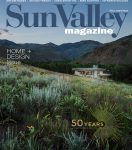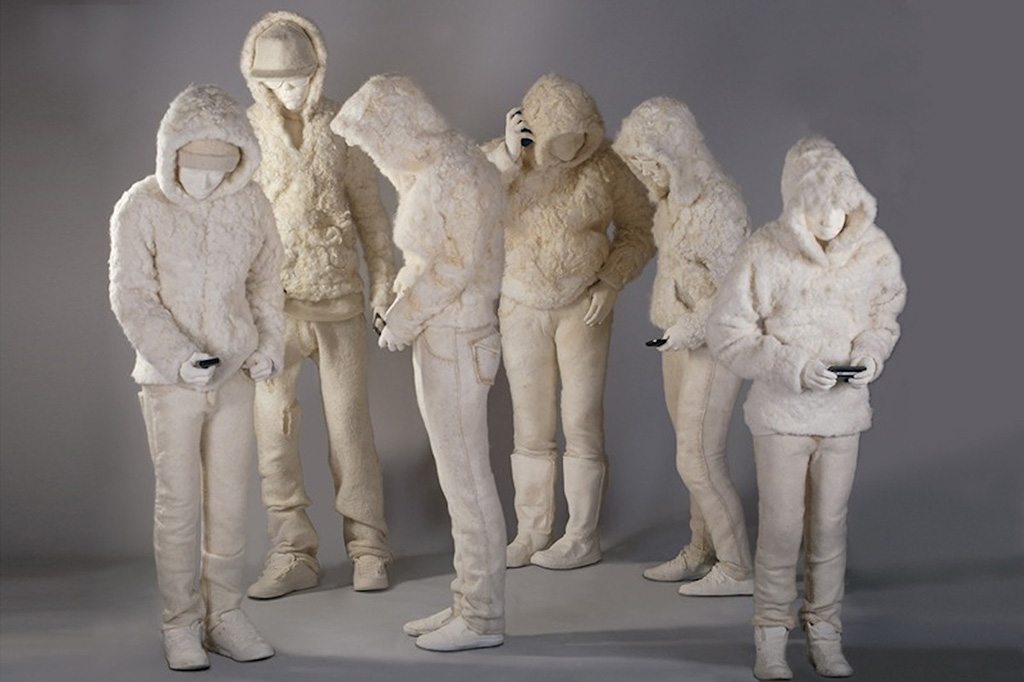A deer covered in a hide of French tapestry emerges from the wall of Pamela DeTuncq’s handsome mid-valley home.
Several more deer stand in the L-shaped garage that she has converted into a studio, signaling her latest foray into her thought-provoking art.
One, boasting a French tapestry of young lovers stretched across its taxidermied form, evokes the idea of youth underneath its long purple eyelashes, feathered tail and sculpted antlers. A tinier version mounted on glass balls features the Mickey Mouse and the Seven Dwarves of DeTuncq’s granddaughter’s memories.
“It started out to be a set of sculptures addressing the issue of death. But soon it became so much fun it wasn’t about death anymore,” said DeTuncq.
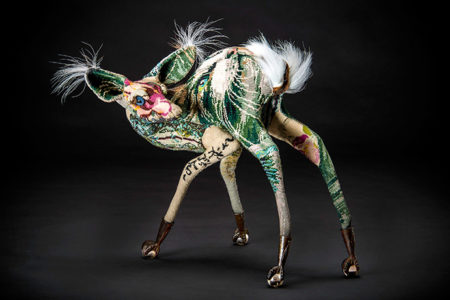
“Fawn All Over,” by Pamela DeTuncq, made from vintage tapestries, glass, deer tail, foam, life size.
“Now I’m addressing vanity,” she said, referring to the still-life paintings of 16th- and 17th-century Flanders that reminded people of the brevity of life. “It’s been a long time since I’ve had fun in my work, and this is fun.”
Indeed, DeTuncq has always been deeply serious about the messages she portrays through her sculptures.
Her venture with the deer had its origins in her mother’s stroke six years ago. When DeTuncq returned to the home where she had grown up, she found thousands of pill bottles occupying every drawer and cupboard.
“My mother was taking 24 prescription drugs a day,” she said. After resettling her mother in a retirement home, DeTuncq gathered up her mother’s pills and brought them home. Then she set about trying to figure out how to tell the story of the overmedication of seniors.
She advertised for an older model to pose nude at the Walla Walla Foundry, not confident that anyone would respond. Her phone rang off the hook.
One call came from an 87-year-old woman who, at 5 feet tall and 80 pounds, was too small for what she wanted. But the woman volunteered her 65-year-old daughter. And soon DeTuncq found herself watching as a foundry technician wove a wand around the woman, creating a digital version on computer.
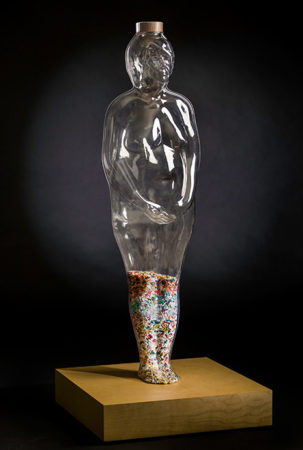
“Part D,” by Pamela DeTuncq. As part of the Aging Project, this sculpture addresses the issue of the over-medication of our country’s elderly. It’s title ‘Part D’ refers to the section of Medicare covering prescription drugs. This life-sized figure containing prescription medication calls attention to the pharmaceutical industry’s far-reaching influence.
A computer numeric controlled (CNC) machine used that information to carve a solid figure out of dense Styrofoam. And from that workers created a clear vessel, which DeTuncq partially filled with blood pressure, thyroid, cholesterol, pain, sleeping, heartburn and other pills.
She topped the human vessel with a bronze lid and titled it “Part D” to refer to the section of Medicare covering prescription drugs.
She then created a bronze cast walker titled “Fall Risk,” reflecting the ubiquitous tool her mother’s friends use to get around. She incorporated knee and hip replacement hardware in the frame and used medical tubing as brake liners. Finally, she created a needlepoint cushion with a set of keys hand-embroidered on it.
“I asked myself: How can I represent what independence looks like? I figured it was the keys to a house you can’t live in anymore and the keys to a car you can’t drive anymore. I wanted them there but not accessible.”
DeTuncq studied fine arts at the University of Maryland near her childhood home. She spent years working in graphic design in Los Angeles before moving to the Wood River Valley in 1995, partly to hike, snowshoe, cross-country ski and take advantage of the outdoor activities available to Wood River Valley residents.
Not content to twiddle her thumbs here, she decided to learn to work in clay—not an easy proposition in the days before Susan Ward started Boulder Mountain Clayworks.
“You couldn’t buy clay here,” DeTuncq recalled. “I had to get it at the College of Southern Idaho art department in Twin Falls.”
The first piece she ever made—that of two giraffes—sits in the children’s waiting room at St. Luke’s Wood River Medical Center. She followed that up with large totems until she realized she was going to have to start working in bronze to produce less fragile works that galleries would accept.
At 50, she decided to get a Master of Fine Arts degree at The Art Institute of Boston.
“I was working in a vacuum in my garage. I didn’t know if I what I was making was good.”
Professors asked her, “Why? Why are you doing what you’re doing?”
“I didn’t know why I was making what I was making,” DeTuncq said. “Making something over and over once I’d learned how was not satisfying, so I began to make conceptual pieces. Every time I start a new project, I start from scratch, learning new skills, working with new material. I’ve been criticized that my work is not recognizable. But trying something new is where I get the most juice.
“My preoccupation is art. I like to make it, talk about it with other artists and give art tours of other artists’ work.”
To gain the confidence to present her master’s thesis in public, DeTuncq began volunteering at the Sun Valley Center for the Arts as a docent, talking about art to kindergarteners and board members.
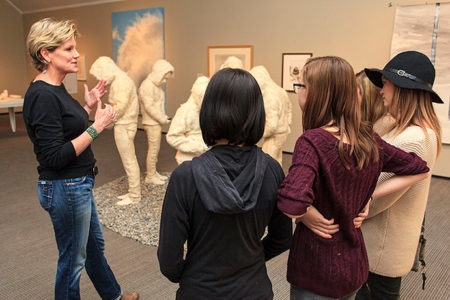
Pamela DeTuncq at a Teen Night talk and workshop at the Boise Art Museum.
It was there that The Center’s curator, Courtney Gilbert, asked her to do an installation as part of an exhibition examining what it means to be a teenager in the 21st century. DeTuncq quickly seized on an experience she’d had watching teenagers talk to one another using a newfangled technology called texting—even though they were standing next to one another at the mall.
She created body casts of six teenagers, each with cellphone in hand. Then she covered the casts in wool felting to represent the idea they were like sheep bent on conformity. “Flock” is now part of the permanent collection at the Dennos Museum in Traverse City, Mich.
DeTuncq created an 8-by-19-foot carpet of thousands of eggshell fragments depicting June Cleaver of “Leave It to Beaver” in a meditation on domesticity and gender roles. A vacuum cleaner stood in the middle of the piece as if to suck up the outdated tasks women were being asked to perform.
She used eggshells again in works for The Advocates representing the fragile notion of relationships in homes.
“Pam’s work is rooted in contemporary life and ideas around gender and the way we do and don’t connect with each other,” said The Center’s artistic director, Kristin Poole, who has mentored DeTuncq. “Her approach to her work is a great mix of conceptual thinking.”

